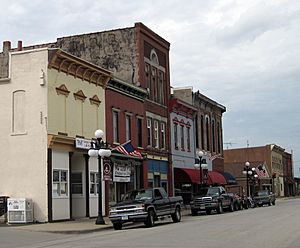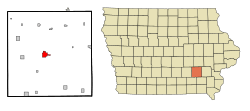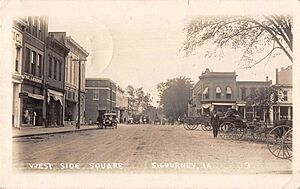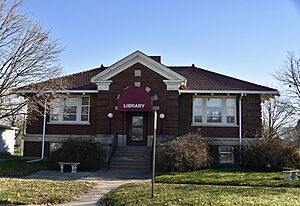Sigourney, Iowa facts for kids
Quick facts for kids
Sigourney, Iowa
|
|
|---|---|

Public Square Historic District
|
|
| Motto(s):
Where tradition meets tomorrow
|
|

Location of Sigourney, Iowa
|
|
| Country | |
| State | |
| County | Keokuk |
| Area | |
| • Total | 2.16 sq mi (5.60 km2) |
| • Land | 2.16 sq mi (5.60 km2) |
| • Water | 0.00 sq mi (0.00 km2) |
| Elevation | 794 ft (242 m) |
| Population
(2020)
|
|
| • Total | 2,004 |
| • Density | 926.49/sq mi (357.64/km2) |
| Time zone | UTC-6 (Central (CST)) |
| • Summer (DST) | UTC-5 (CDT) |
| ZIP code |
52591
|
| Area code(s) | 641 |
| FIPS code | 19-73110 |
| GNIS feature ID | 2395884 |
| Website | http://www.sigourney-iowa.com |
Sigourney (pronounced SIG-ər-nee) is a city in Iowa, United States. It is the main town, or county seat, of Keokuk County. In 2020, about 2,004 people lived there. The Keokuk County Courthouse is in a special area called the Public Square Historic District. Both are important historical places listed on the National Register of Historic Places.
Contents
History of Sigourney
People started settling in Keokuk County in 1843. The town of Sigourney began in 1844 when S.A. James built the first house there. More families soon moved in.
In 1844, Dr. George H. Stone, a county commissioner, named the town. He chose the name to honor Lydia Sigourney, a very popular poet at the time. You can still see a big painting of her in the county courthouse today.
Geography and Climate
Sigourney is located in Iowa. The city covers an area of about 2.18 square miles (5.6 square kilometers). All of this area is land.
Sigourney's Climate
Sigourney has a type of climate called a hot-summer humid continental climate. This means it has warm, humid summers and cold winters.
The hottest temperature ever recorded in Sigourney was 113°F (45°C). This happened on July 22, 1901. The coldest temperature recorded was -32°F (-36°C) on January 31, 2019.
People of Sigourney
Sigourney has seen its population change over the years. Here's a quick look at how many people have lived there:
| Historical populations | ||
|---|---|---|
| Year | Pop. | ±% |
| 1850 | 162 | — |
| 1870 | 992 | +512.3% |
| 1880 | 1,735 | +74.9% |
| 1890 | 1,523 | −12.2% |
| 1900 | 1,952 | +28.2% |
| 1910 | 2,032 | +4.1% |
| 1920 | 2,210 | +8.8% |
| 1930 | 2,262 | +2.4% |
| 1940 | 2,355 | +4.1% |
| 1950 | 2,343 | −0.5% |
| 1960 | 2,387 | +1.9% |
| 1970 | 2,319 | −2.8% |
| 1980 | 2,330 | +0.5% |
| 1990 | 2,111 | −9.4% |
| 2000 | 2,209 | +4.6% |
| 2010 | 2,059 | −6.8% |
| 2020 | 2,004 | −2.7% |
| Source: and Iowa Data Center Source: |
||
2020 Population Details
In 2020, there were 2,004 people living in Sigourney. There were 880 households, which are groups of people living together. About 513 of these were families.
Most people in Sigourney (94.6%) were White. A small number were Black or African American (0.9%), Native American (0.1%), or Asian (0.2%). About 1.0% were from other races, and 3.2% were from two or more races. People of Hispanic or Latino background made up 1.9% of the population.
The average age in Sigourney was 45.7 years old. About 22.1% of residents were under 20 years old. Also, 26.5% were 65 years old or older. The city had slightly more females (52.5%) than males (47.5%).
Education in Sigourney
The Sigourney Community School District serves students from Sigourney and nearby towns. It covers an area of almost 70 square miles (181 square kilometers).
About 700 students attend school in the district each year. Around 350 students are in elementary school (kindergarten to 6th grade). Another 350 students attend junior and senior high school (7th to 12th grade).
On average, about 50 students graduate from high school each year. A large number, about 80%, go on to college. The school's mascot is the Sigourney Savage.
The city also has a public library called the Sigourney Public Library.
Notable People from Sigourney
Many interesting people have come from Sigourney, Iowa. Here are a few:
- William Lawrence Adrian (1883–1972), a Roman Catholic bishop.
- Ambrose Burke (1895–1998), a Roman Catholic priest and teacher.
- John Burke (1859–1938), who was the tenth Governor of North Dakota, and also a judge and United States Treasurer.
- Katharine Goeldner, a talented opera singer.
- Ernest L. Parker (1864–1934), who served as the 13th Lieutenant Governor of Idaho.
- Dan Peiffer (born 1951), a former NFL football player.
- Ezekiel S. Sampson (1831–1896), a judge and a U.S. Representative (meaning he was part of the U.S. Congress).
Images for kids
See also
 In Spanish: Sigourney (Iowa) para niños
In Spanish: Sigourney (Iowa) para niños





